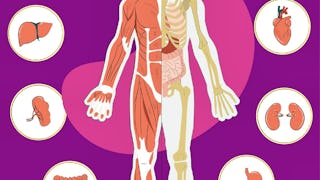In this course, you will gain the necessary scientific education that provides the groundwork for the application of safe and effective programming for fitness clients. Anatomy, Physiology, and Kinesiology are the sciences that provide the basis for fully understanding the parts of the body, how it works, and how it moves. It is vital for personal fitness trainers to have a strong understanding of anatomical structures, systems, and their functions to help guide clients in achieving their goals. By applying the understanding of Anatomy, Physiology, and Kinesiology in a fitness setting, you will be able to design and implement safe and effective exercise programs that meet the diverse needs of each client. This course will help you understand these concepts as a basis for applying them in real-world settings.


Anatomy, Physiology, and Kinesiology for Fitness Professions
本课程是 NASM Personal Fitness Trainer 专业证书 的一部分

位教师:Casey DeJong
8,735 人已注册
包含在 中
您将学到什么
Explain the roles of the nervous, skeletal, and muscular systems in human movement.
Apply principles of biomechanics and kinesiology to optimize movement patterns.
Design individualized fitness programs using knowledge of anatomy, physiology, and biomechanics.
您将获得的技能
要了解的详细信息
了解顶级公司的员工如何掌握热门技能

积累 Basic Science 领域的专业知识
- 向行业专家学习新概念
- 获得对主题或工具的基础理解
- 通过实践项目培养工作相关技能
- 通过 National Academy of Sports Medicine 获得可共享的职业证书

该课程共有5个模块
The study of the human movement system encompasses the essential principles of anatomy and physiology, focusing on the kinetic chain, which includes the skeletal and muscular systems. This comprehensive overview explores how these systems interact to facilitate movement, detailing the structure and function of bones, joints, and muscles. Emphasis is placed on understanding how posture, activity, and nutrition impact body mechanics and overall functionality. This foundational knowledge is crucial for fitness professionals dedicated to optimizing human performance and preventing injuries. Upon completion of this week’s lessons, the aspiring fitness professional will be able to:
涵盖的内容
7个视频9篇阅读材料6个作业2个插件
The nervous system, a complex network of billions of cells, functions as the communication hub within the human body, integrating sensory, integrative, and motor functions to maintain internal and external balance. Sensory functions allow the nervous system to detect changes in the environment, integrative functions process and interpret these sensory inputs, and motor functions generate appropriate neuromuscular responses. The system is divided into the central nervous system, comprising the brain and spinal cord, and the peripheral nervous system, consisting of cranial and spinal nerves along with sensory receptors. Understanding of how the nervous system responds to exercise is essential for developing proper movement patterns and reducing injury risk. Upon completion of this week’s lessons, the aspiring fitness professional will be able to:
涵盖的内容
2个视频6篇阅读材料5个作业1个插件
Understanding the basic physiological mechanisms of energy conversion is crucial before designing exercise programs for clients. Bioenergetics, the study of energy in the human body, examines how chemical energy from food is transformed into mechanical energy for muscle contractions. The cardiorespiratory system, consisting of the cardiovascular and respiratory systems, ensures the delivery of oxygen, nutrients, and waste removal for optimal cellular function. The cardiovascular system includes the heart, blood, and blood vessels, while the respiratory system manages the intake and exchange of oxygen and carbon dioxide. Additionally, the body utilizes three primary bioenergetic pathways—ATP-PCr, glycolysis, and oxidative—to produce ATP, the essential energy source for physical activity. Upon completion of this week’s lessons, the aspiring fitness professional will be able to:
涵盖的内容
5个视频7篇阅读材料6个作业1个插件
Biomechanics and kinesiology apply principles of physics to analyze how forces interact within the human body, focusing on the movements produced by the kinetic chain and the forces acting upon it. This includes understanding anatomical terminology, planes of motion, joint movements, muscle actions, levers, and muscle synergies. Health and fitness professionals must grasp these concepts to effectively communicate and design training programs that optimize movement and prevent injuries. Upon completion of this week’s lessons, the aspiring fitness professional will be able to:
涵盖的内容
7个视频8篇阅读材料6个作业4个插件
The final quiz is designed to assess your understanding and mastery of the key concepts covered throughout the course. It will include questions from all the major topics discussed in Weeks 1 to 4, ensuring that you have a solid grasp of the principles and practices of advanced personal fitness training. The final peer-reviewed assignment aims to assess your practical skills in evaluating and analyzing the kinetic chain components involved in specific exercises, explaining the function of the muscular system, using basic anatomical terminology, and understanding different types of muscle actions. By completing it, you will demonstrate your ability to analyze and assess kinetic chain components during exercise, use anatomical terminology, and understand muscle actions in various movements.
涵盖的内容
1个作业1次同伴评审
获得职业证书
将此证书添加到您的 LinkedIn 个人资料、简历或履历中。在社交媒体和绩效考核中分享。
位教师

从 Basic Science 浏览更多内容
 状态:免费试用
状态:免费试用National Academy of Sports Medicine
 状态:免费试用
状态:免费试用National Academy of Sports Medicine
 状态:预览
状态:预览The Chinese University of Hong Kong
 状态:免费试用
状态:免费试用National Academy of Sports Medicine
人们为什么选择 Coursera 来帮助自己实现职业发展




学生评论
57 条评论
- 5 stars
81.96%
- 4 stars
4.91%
- 3 stars
8.19%
- 2 stars
0%
- 1 star
4.91%
显示 3/57 个
已于 Oct 27, 2025审阅
I really like info and the approach of all concepts
已于 Jan 3, 2025审阅
Would have liked to see more visuals for muscular system.
已于 Sep 1, 2025审阅
Really thorough, but never too in-depth to lose someone. Enjoyed it and will becoming back to the material a lot.
常见问题
To access the course materials, assignments and to earn a Certificate, you will need to purchase the Certificate experience when you enroll in a course. You can try a Free Trial instead, or apply for Financial Aid. The course may offer 'Full Course, No Certificate' instead. This option lets you see all course materials, submit required assessments, and get a final grade. This also means that you will not be able to purchase a Certificate experience.
When you enroll in the course, you get access to all of the courses in the Certificate, and you earn a certificate when you complete the work. Your electronic Certificate will be added to your Accomplishments page - from there, you can print your Certificate or add it to your LinkedIn profile.
更多问题
提供助学金,
¹ 本课程的部分作业采用 AI 评分。对于这些作业,将根据 Coursera 隐私声明使用您的数据。




